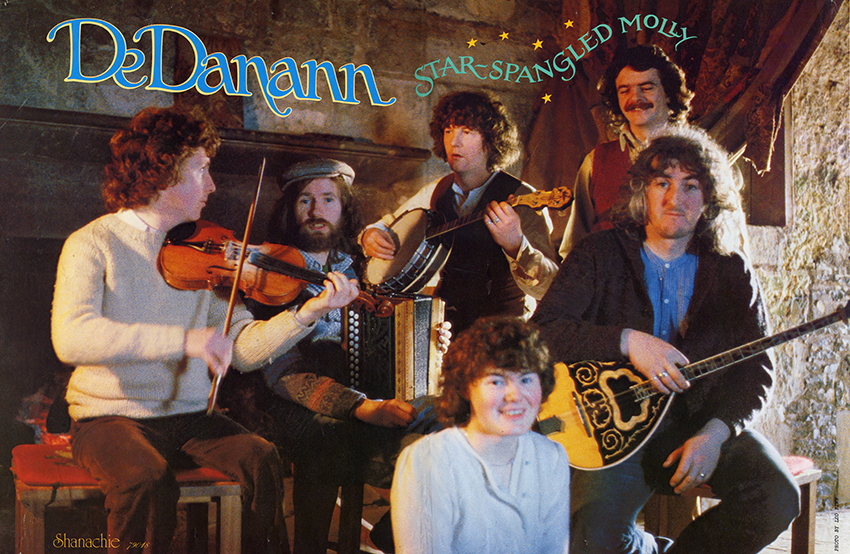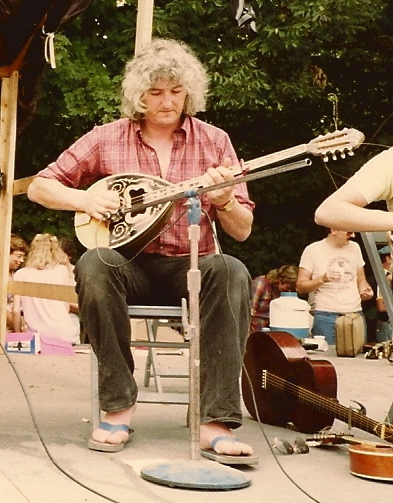ALEC FINN’S BOUZOUKIS & OTHER INSTRUMENTS
by Kevin HJ Macleod
Alec Finn is internationally accredited as being one of the original four traditional musicians to have pioneered the use of the traditional Greek bouzouki in Ireland in the 1970s. Johnny Moynihan, Andy Irvine, Donal Lunny and Alec Finn all began introducing the bowl back Greek instruments into the song and instrumental traditions in Ireland with such groundbreaking bands as Planxty, The Bothy Band, Sweeney’s Men, and, in Alec Finn’s case, the great Galway based band De Danann. However, only Finn used the older form of the bouzouki, the bowl backed trichordo, with 3 courses of 6 strings. The other three musicians favoured the later model with 4 courses of 8 strings.
The first recording of Alec and fiddler Frankie Gavin’s group De Danann appeared in 1975, not long after the group got together for informal sessions in Hughes’s Bar in Spiddal, Connemara around 1974/5. This is the first time that the distinctive accompaniment style of Alec is heard, coupled with the unique bouzouki duets with Charlie Piggott playing melody on a bouzouki, a new and special sound to many. Here we hear the earliest bouzouki that Alec Finn had acquired.
The second album “Selected Jigs, Reels and Songs” appeared in 1977, and on this, singer Johnny Moynihan also plays the bouzouki. Alec seems to have taken up a second instrument at this time, one of a pair that Moynihan may have found in Greece. Alec used this ornate instrument for a long time thereafter.
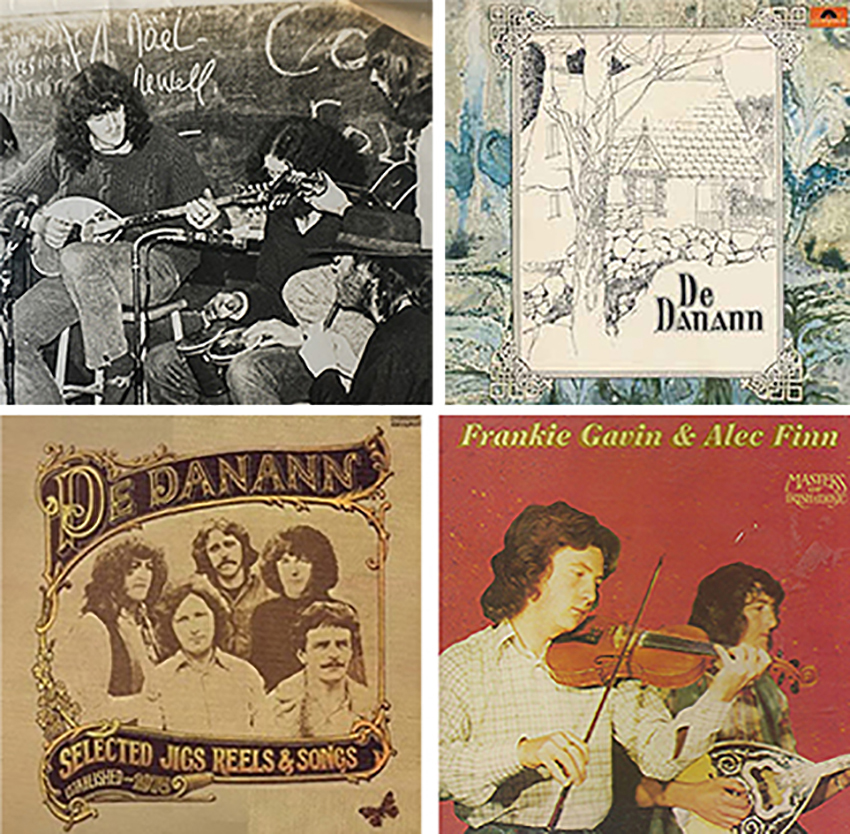
Also in 1977, a seminal duet album was released, by Dan Collins’s Shannachie Records in New York, of Frankie Gavin accompanied by Alec Finn. This was apparently recorded in an afternoon, with a bottle of Jack Daniels to hand, Alec once told me, practically in single takes! It remains one of the most important recordings in traditional Irish music, a supreme bench mark for so many who follow the music. Alec is seen playing the second bouzouki on the cover of the album above.
In more detail, it is interesting to look at Alec’s story, through his passion and use of such unusual instruments at that time.
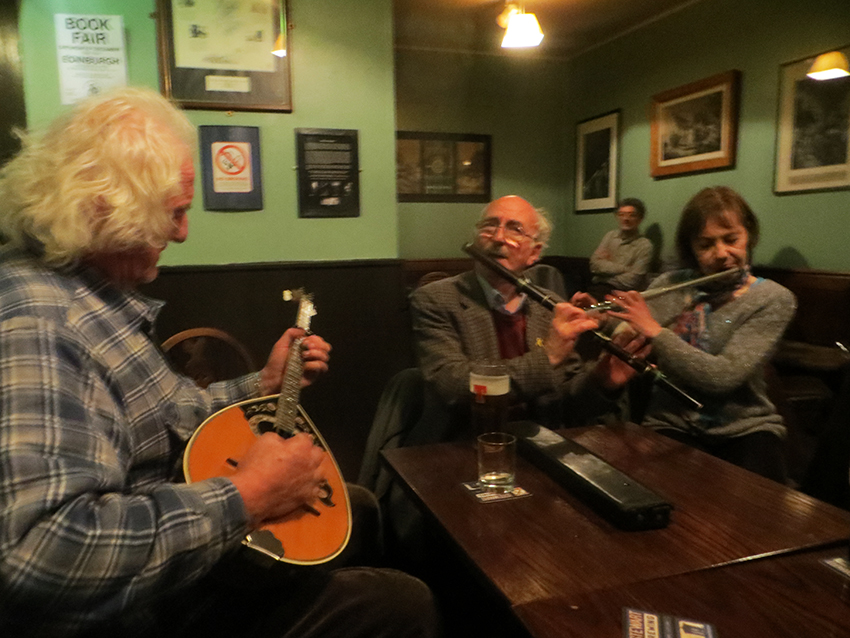
Alec Finn & Cathal McConnell, The Oxford Bar, Edinburgh, 2015
In an interview done in 2015 in Edinburgh, Alec recollected that “I had an art teacher at art college who played the classical guitar, which I’d had never really heard before, and then I bought a thing called a Lacote guitar which is a French ladies guitar, very waisted, in a junk shop for a fiver, somewhere in Yorkshire, a gut stringed guitar, but I could never do the classical thing, much as I would have loved to ...”
As to ending up getting a bouzouki, Alec recollected “When I went to Ireland when I was 18, in 1962, (born 1944) I had a guitar for about 6 or 7 years. A friend of mine Eamonn Cannon went to Greece and brought a bouzouki back, about a year or so afterwards I moved down to the West (1972) and just started flaking around with it, really, at sessions.”
More specifically, “I got interested in lutes and bowl back instruments, particularly lutes, and I heard that a friend of mine was going to Greece, a long, long time ago when people didn’t go to Greece, it wasn’t a holiday place, but a friend of mine was going from Dublin (in 1970 - obituary) and I asked him to get me thing called a lauto, which was a large lute like instrument made and played in Crete, and it looks like a sort of mediaeval lute and I thought it would be nice to have, sort of hang on the wall, and he brought me back a bouzouki by mistake which he bought in the Plaka in Athens and it was, like third hand and pretty banjaxed. It was in that DAD tuning, it was a trichordo, modally tuned. He brought me this back by mistake. Cost three quid! I started playing that a little bit around Dublin, and then when I moved down to the West of Ireland around Spiddal I started playing it in sessions in the local pub. The first time I saw a bouzouki, an English singer Anne Briggs, herself and Johnny Moynihan were doing a ‘line’, and she brought over a Greek bouzouki which she bought in a junk shop in England somewhere.”
I also recollect Alec telling me that he had been keen on the music of Julian Bream, and was interested in the lute that Bream was notable for playing in the 1960’s.
Early on he seems to have adopted a capo to enable him to change key, when accompanying. The elasticated Dunlop style banjo capos were around then, and he used one for many years, one of his which I have as a memento, until the Quickdraw capos appeared, and he used those exclusively from then on.
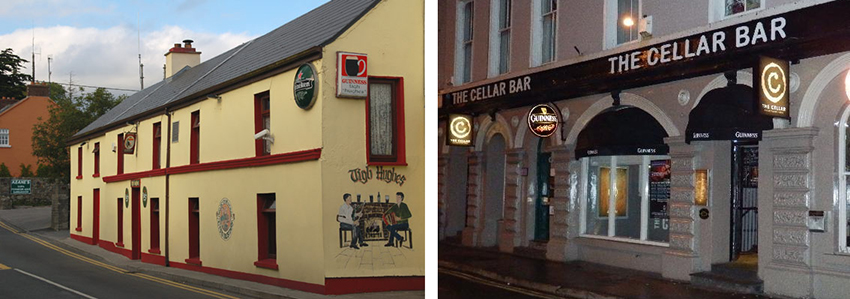
The main pub session that Alec frequented when he went to Galway from Dublin was at Tigh Hughes in Spiddal, but he recollected that there were others in Galway at The Cellar Bar, and The Eagle where the Comhaltas Ceoltoiri Eireann players gathered. The early incarnation of De Danann (Frankie Gavin – fiddle, Charlie Piggott – banjo, mandolin, bouzouki & melodeon, Johnny McDonagh – bodhran & bones, Dolores Keane – vocals and Alec Finn – bouzouki & guitar) came out of those sessions in Hughes’s, and soon an invite to play a concert in Dublin was taken up and not long after the band went to America as part of the USA bicentenary celebrations in 1976. The line up was fixed at that time, until Dolores Keane left to marry singer John Faulkner and go to London.
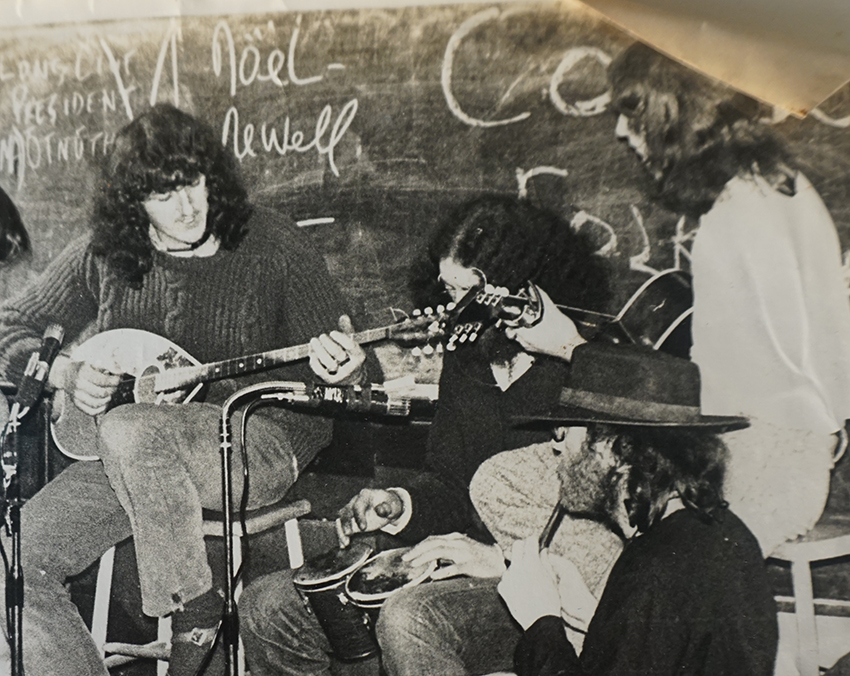
This early black and white photograph (above) was seen in an old scrapbook of Alec’s at the time of the TG4 filming for the documentary on Alec’s life in 2018. It clearly shows a trichordo bouzouki with the set of machine heads with 4 tuners on each side. It seems that these were more readily available to makers in the 1960’s. This appears to be the original instrument that was brought back, and it is subsequently seen in the video of De Danann, with singer Johnny Moynihan having replaced Dolores Keane, filmed live at The Embankment in Dublin in 1976.
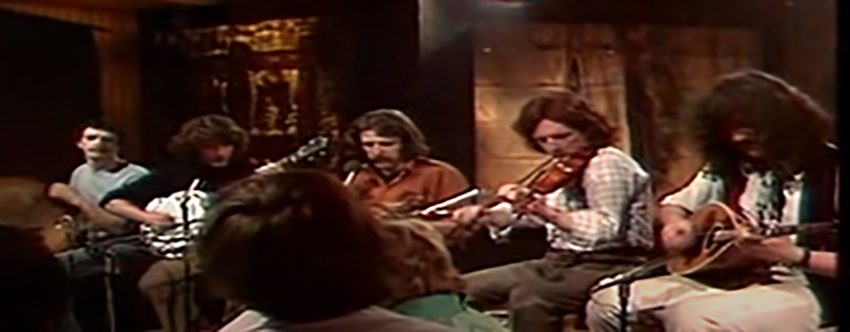
In a recent conversation in October 2020 with Frankie Gavin, he recalled that when he first got together with Alec the bouzouki he had then was “plain enough, it hadn’t got all that Greek stuff on it, it was a plain body and I think it had a kind of a maroon or burgundy coloured simple pick guard, it was really plain.” This is surely the first instrument.
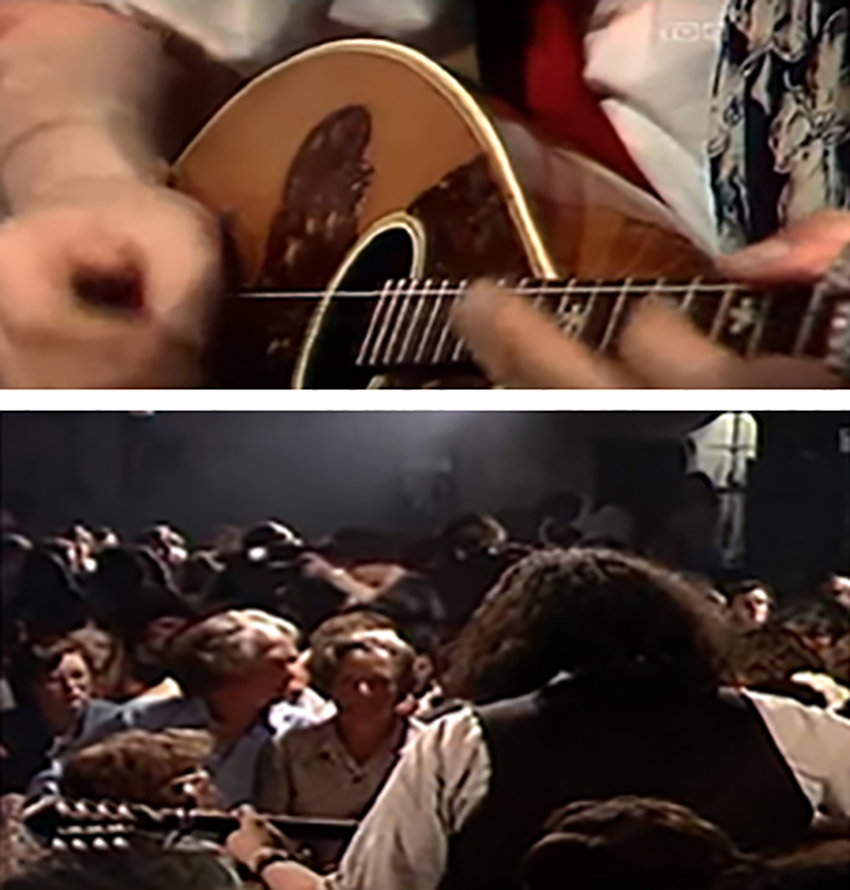
It can be seen during the 1976 video taken at the wonderful live concert at The Embankment. https://www.youtube.com/watch?v=o0BAD4ibvqM It has simple wing shaped fret markers, pairs of 4 on a plate machineheads, no fancy body ornamentation, and a plain oval soundhole with a simple w/b/w soundhole rosette edging, all the same as in the first photograph. But interestingly, Frankie also mentioned in that recent conversation that he thought that Moynihan had brought two bouzoukis back from Greece, and had passed one to Alec. And in the same video, both Alec and Moynihan play what looks like a pair of much more ornamented instruments at the gig as well, Alec swapping between the old and the new at one point.
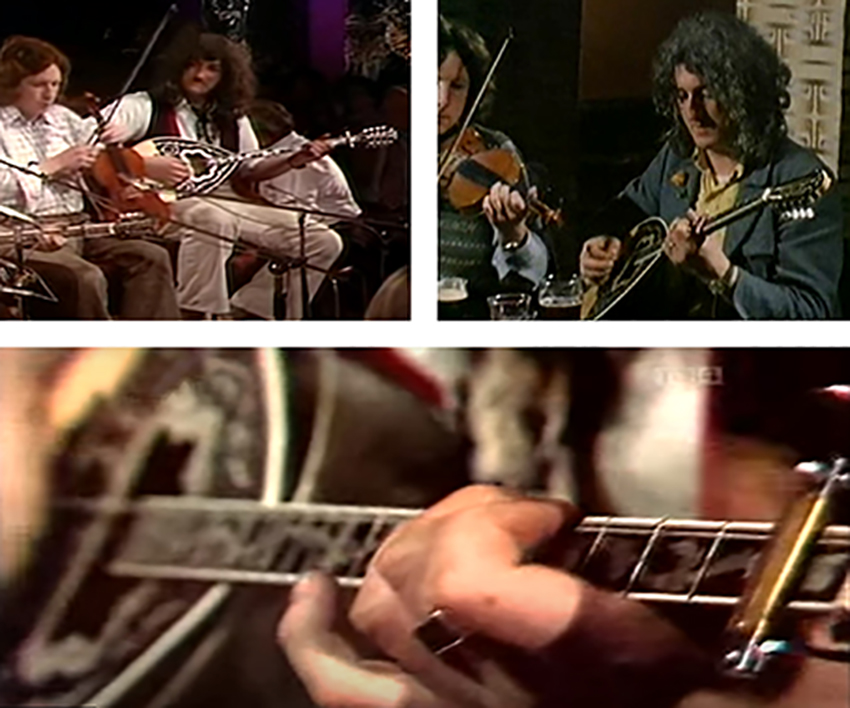
This second instrument has beautiful inlay on the body, scratchplate and fretboard, something that would have undoubtedly greatly attracted Alec’s artistic eye. He seems to have used this instrument as his main gigging and recording bouzouki for a long time, and was still using it in the 1980s right through the busy touring schedules of that time. It appears in many of the surviving videos from that time, and has a fine, bassy, full tone to it. https://www.youtube.com/watch?v=Qeoz5WfTeIc It was kept in a very solid green glass fibre bouzouki case, which took a lot of travel punishment and kept the instrument very safe. This was possibly made in England, and, at that time both Gavin and McDonagh had cases made for their instruments as well. This second bouzouki last appears on the cover of “A Jacket of Batteries” in 1988. It may well have been that the string action pulled the neck irreparably, as can happen on such long necked instruments after a long period of use and travel. Alec said that he had given it away to a museum collection of Irish music, but he didn’t have much in the way of detail about its destination or end.
Sometime thereafter, Alec was told of a bouzouki maker Victor Dekavallas in Thessaloniki, in northern Greece. I recall that Alec had met an Austrian musician at a festival in Scandinavia who gave him the contact information for Dekavallas. Alec and his great friend and whistle maestro Sean Ryan of Leap Castle, County Offaly, Ireland went over to Thessaloniki, and procured the third bouzouki, seen on the next De Dannan record cover of “Half Set in Harlem”. https://www.youtube.com/watch?v=A1REW88NJ74 Thus began an affiliation with Alec’s music and the Dekavallas workshop, as followers of Alec’s music would also strive to find bouzoukis by this excellent maker. https://www.dekavalas.gr/index.php?lang=en
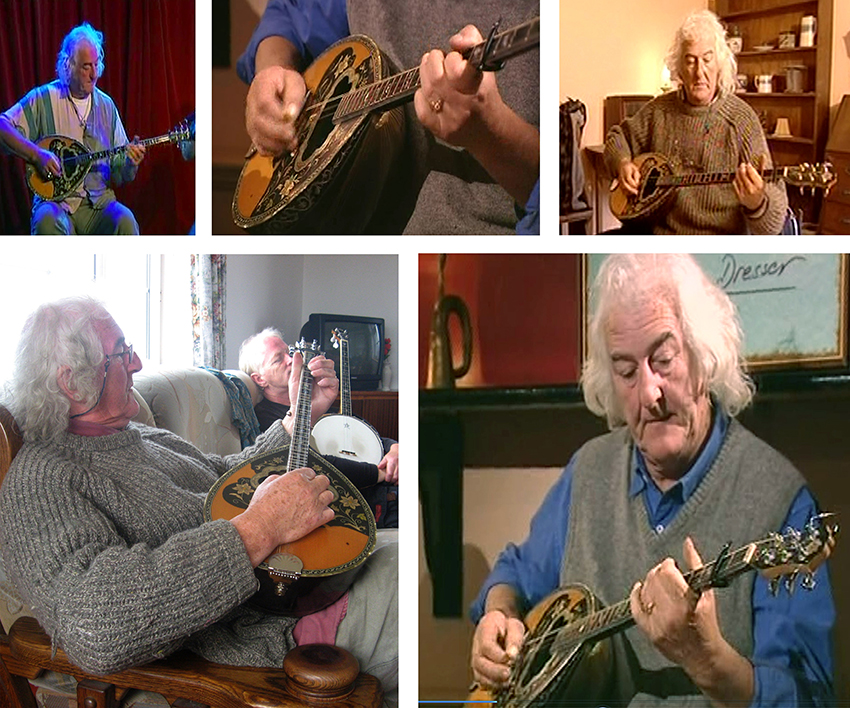
The instrument had modern machineheads installed back in Ireland at the beginning of its use by Alec, and a Headway pickup installed. Late in its life, Alec further modified it with extra “bling” with the addition of more fretmarker inlays, and a lovely brass butterfly tailpiece, mirroring the original scratchplate inlays. Fortunately, it fitted the old green case.
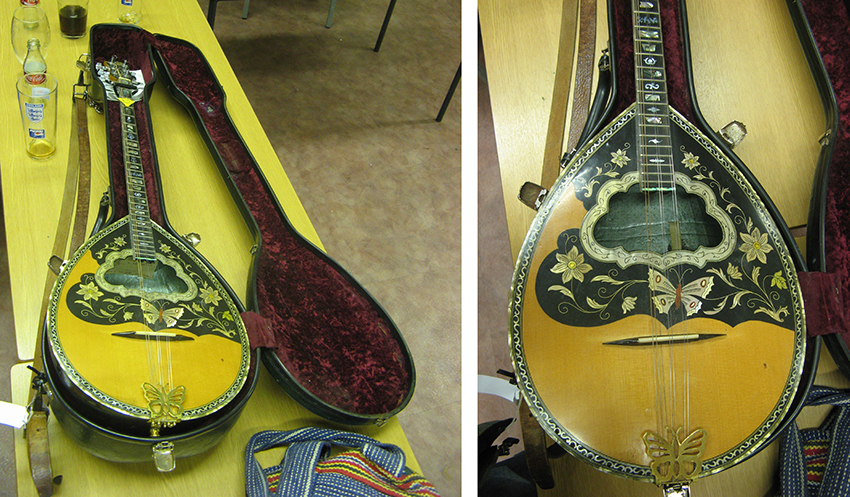
In 2020, bouzouki player John Ryan of Dublin, a keen follower of Alec Finn’s style of playing, commissioned a close replica of the above bouzouki from Victor Dekavallas. A local jeweller in Thessaloniki has replicated the beautiful butterfly design tailpiece. Poignantly, it seems the maker had actually been in the throes of making a presentation bouzouki for Alec, as a thank you for all the orders he had received from Ireland and beyond, but sadly Alec passed away in November 2018.
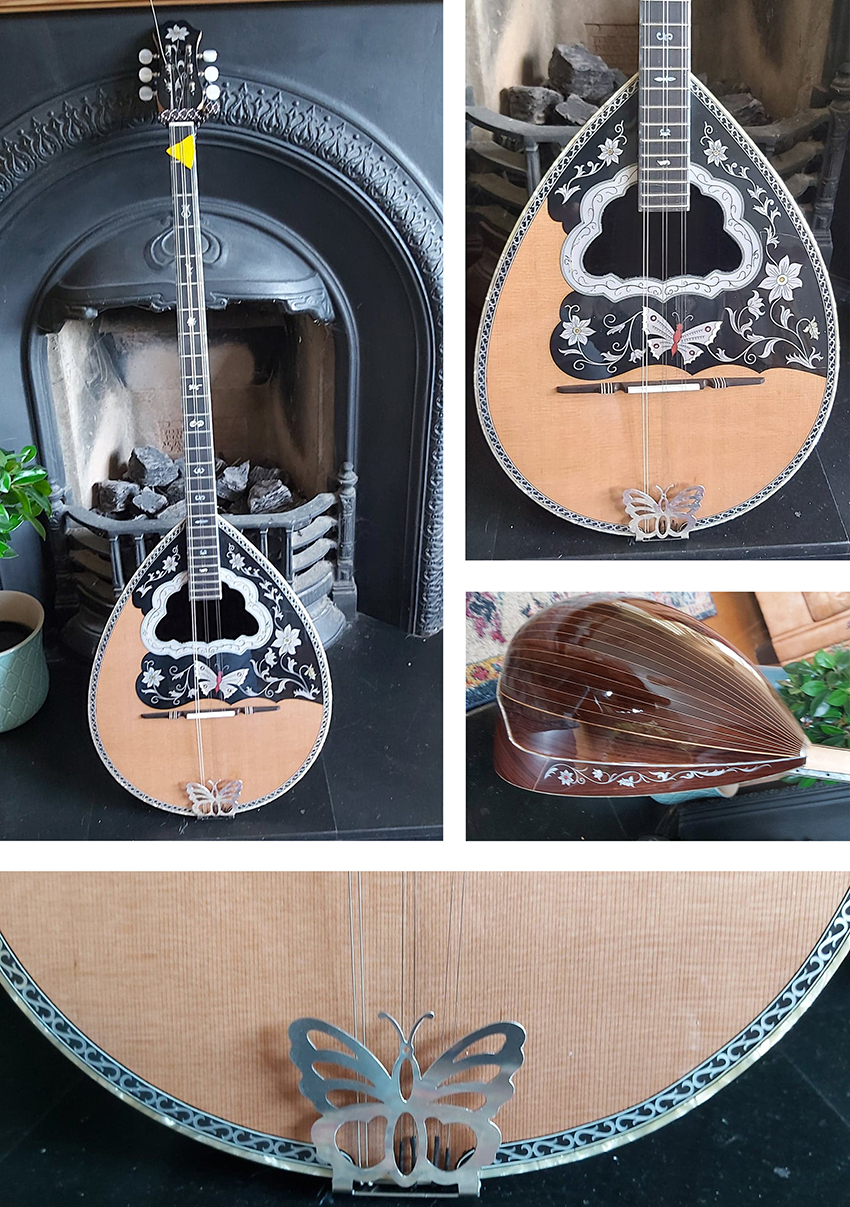
But Alec did get a final Dekavallas bouzouki which he used briefly in his final spell of professional playing. In conversation in 2016 with myself, Alec mentioned that a new and little used trichordo was for sale in Dublin, and I encouraged Alec to go and get it. He headed up to Dublin by train from Galway, and went to buy it from the seller, who had bought it in an attempt to play like a certain Alec Finn. Imagine his surprise when Alec turned up at the door to buy it! He used it in the last big gig at the 2017 Cork Folk Festival when launching De Danann’s melodeon player Aidan Coffey’s fine new solo cd “The Cornerhouse Set”, a wonderful back to basics set of Irish tunes true to the unique De Danann sound.
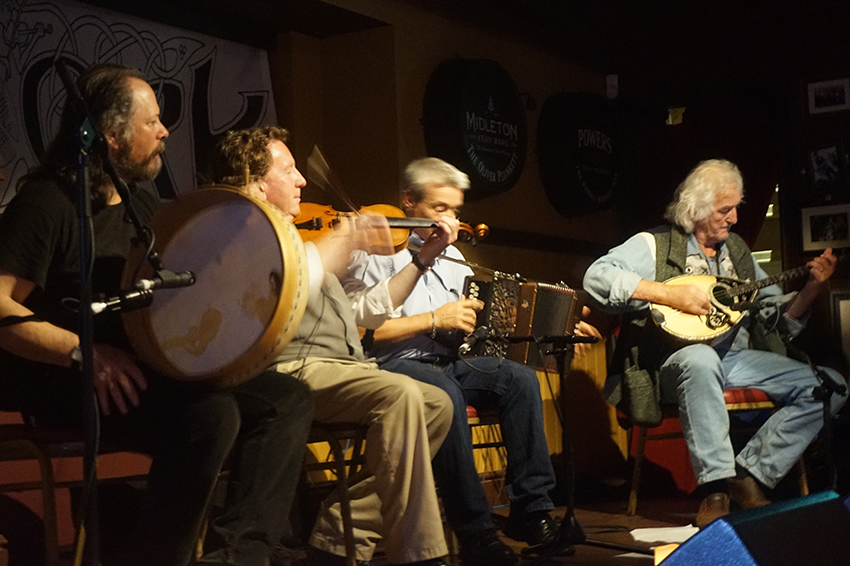
De Danann, Cork Festival 2017
Colm Murphy - bodhran, Frankie Gavin - fiddle, Aidan Coffey - accordion, Alec Finn - bouzouki
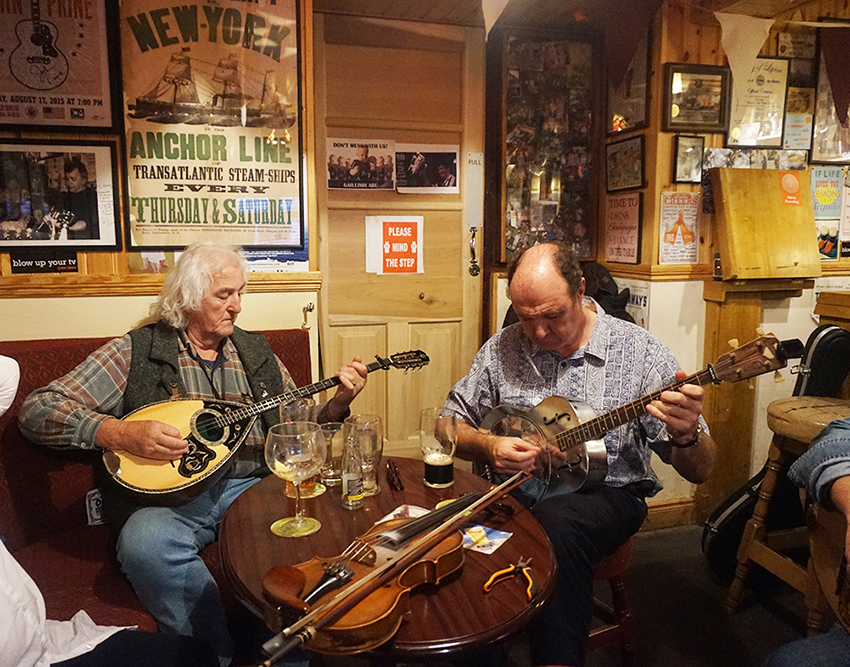
The session back in Green’s Bar in Kinvara shortly afterwards was brilliant, a swansong afternoon of superb music and song.
Another unusual instrument did briefly feature in Alec’s playing during the 1970s, aside from his bouzoukis and guitars. Alec found an early 20th century “teens” Gibson A model mandocello, picked up in America back in the late 1970’s. This can be heard on the superb Noel Hill & Tony Linnane recording of 1979, and also in De Danann’s 1980 “Mist Covered Mountains” and 1981“Star Spangled Molly” records of that time. I suspect that Alec felt that there wasn’t quite enough of a bass sound in his accompaniment, and he seems to have experimented in the recording studio with this heavily strung oval bodied Gibson mandocello. But he didn’t use it much thereafter as far as I can tell.
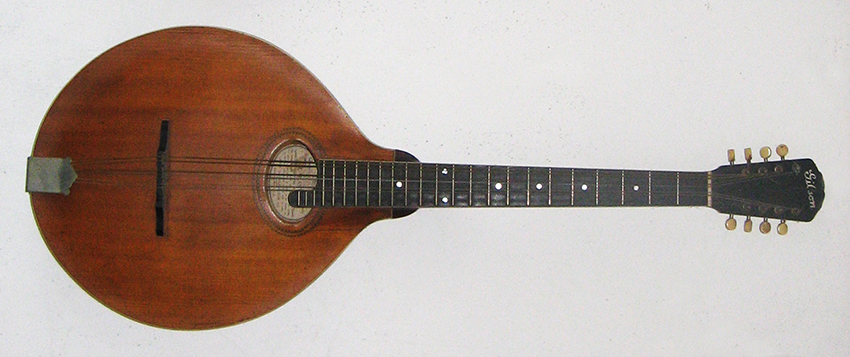
Alec Finn's Gibson mandocello
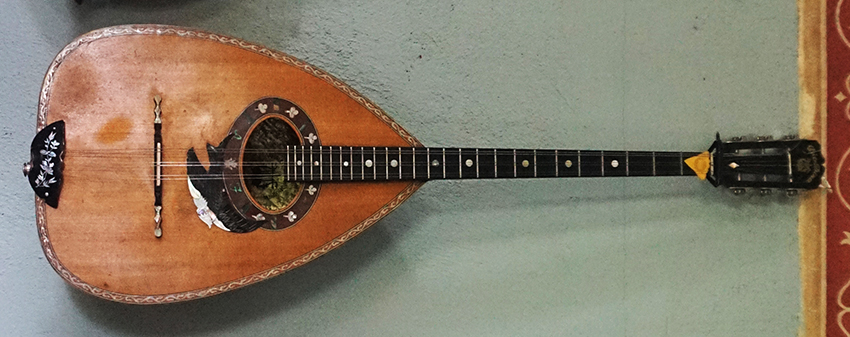
Alec Finn's Dio Dinos bouzouki
Mention too should be made of a selection of other instruments that Alec acquired and used on various recordings over time. At some point he got a larger bodied lauto-like instrument from New York Greek bouzouki maker Dio Dinos. It was custom made for Alec, tuned DAD, featuring his signature shamrocks and a bird inlay lifted off another older flat backed bouzouki. Alec used the Dio Dinos bouzouki on a ‘Hup!’ TV programme in 2016 accompanying Noel Hill and Tony Linnane. https://www.youtube.com/watch?v=dMTBRMMf6JY&t=50s
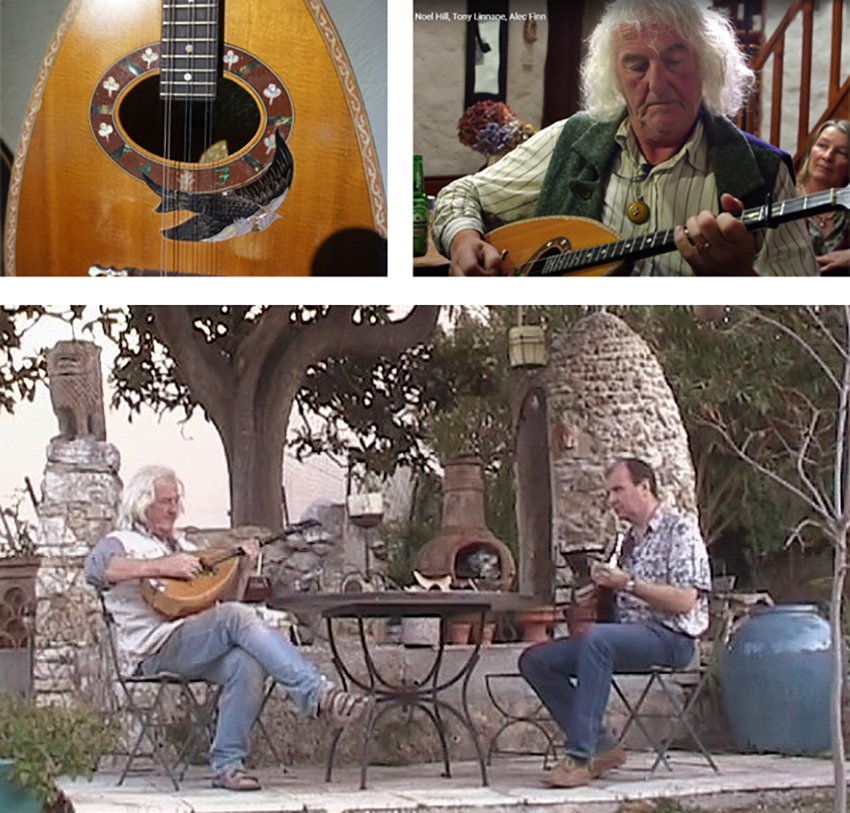
Alec Finn with Dio Dinos bouzouki & mandolinist Kevin Macleod, Vence, Cote D'Azur, France, 2007
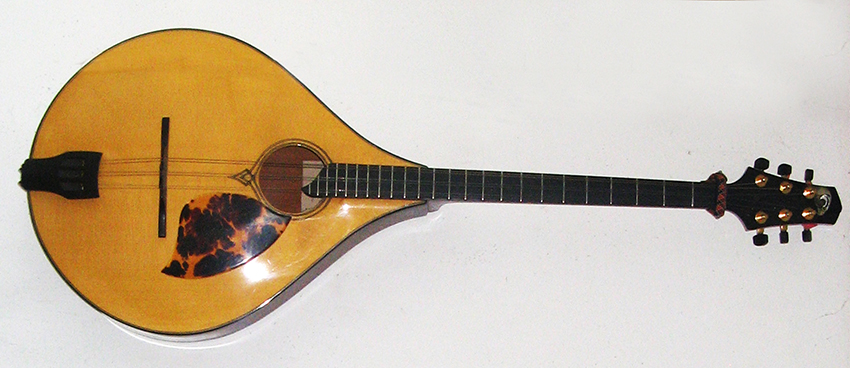
Alec Finn's Steve Owsley Smith "Hawk" bouzouki, 2003
Alec was invited to several memorable Zoukfests by American musician and festival director Roger Landes. These great gatherings of bouzouki aficionados were held annually in various locations in New Mexico, USA. Alec asked me to go with him in 2003 to Taos, New Mexico, ostensibly to play melodies against which he would then be able to demonstrate his accompanying style in workshops, and to perform together at the concerts. It was a memorable trip and huge honour for me. https://vimeo.com/18537539
At that time, an amazing local luthier Steve Owsley Smith had a workshop in a converted yellow school bus in Taos and was making exceptionally lovely stringed instruments. Steve had made a number of bouzoukis, mandolins, mandolas and 5 course instruments which were owned and played by many of the talented local musicians, and also acquired by Zoukfest attendees from further afield in America and Europe, and were highly prized.
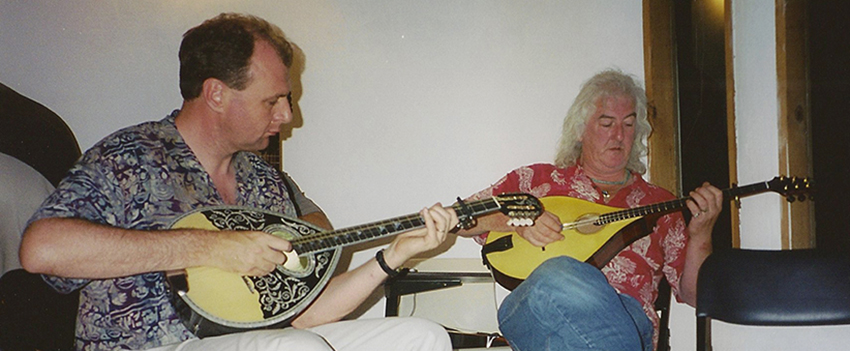
Steve surprised Alec when he arrived by producing an archtop, flatback, trichordo bouzouki specifically made for Alec, with a distinctive hawk inlaid in the headstock. It had a fine spruce soundboard, Cuban mahogany body and beautiful inlays echoing the local Zuni Indian artwork style. Unfortunately, Alec was never a fan of flat bodied bouzoukis, and he didn’t play it at all thereafter. It hung around the walls of Oranmore Castle in Ireland, until a few years later it went back to America and was sold on.
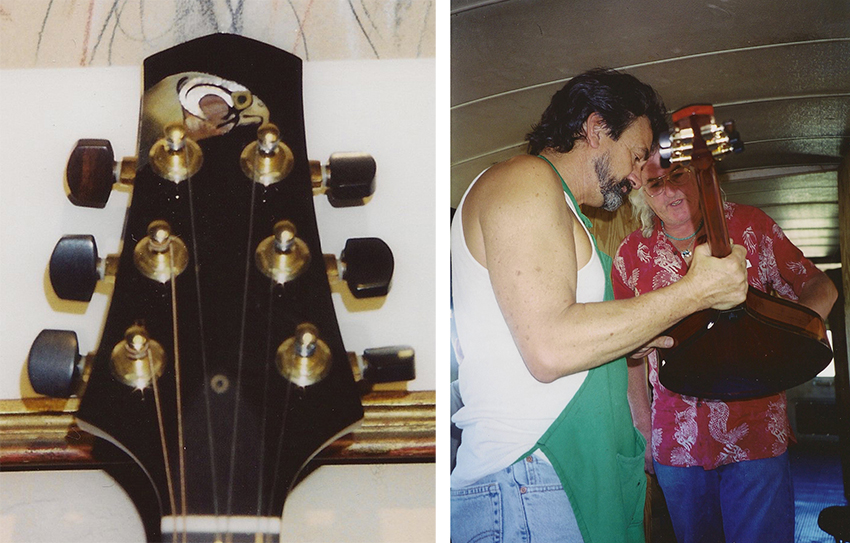
Alec was a hugely in-demand accompanist and he enhanced a significant number of recordings for many high profile musicians in Irish music. One such association was with fiddler John Carty, with whom Alec played on a number of recordings using a tenor guitar. He also recorded with a tenor guitar on a series of albums with his great musical friend, harper Kathleen Loughnane. He had a few wooden tenor guitars, and latterly he acquired a black bodied F5 mandola, with highly exotic inlays, which I believe came from the Far East via Johnny McDonagh. He very much liked the look of it.
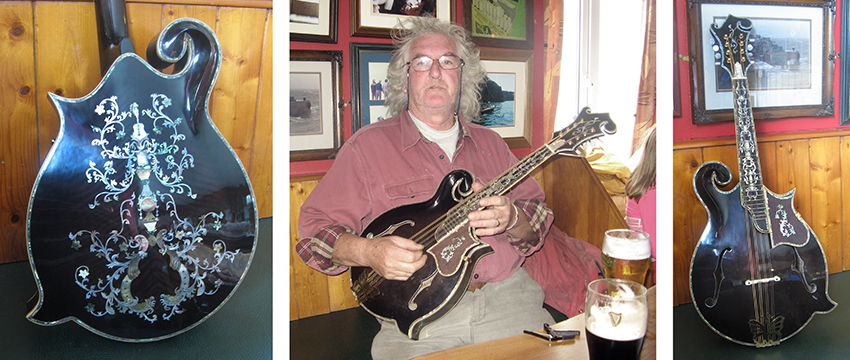
Mention too should be made of another unique instrument that Alec found in America and brought back; the shiny metal bodied single cone National tenor guitar. This appears first on the 1980 “Mist Covered Mountain” album and then briefly on the 1981 “Star Spangled Molly” recording. Its unique honky, jangling sound added a distinctive and unusual new colour. https://vimeo.com/26553352 In fact, Alec was an early pioneer of playing and recording with tenor guitars in traditional music. In a recent correspondence with National guitars expert Mark Makin, he observed this about Alec’s tenor;
“Alec Finn’s is also interesting (the one with the brown/black mottled plastic headstock and white shield). This has obviously been stripped of its’ Triolian brown, fireglow finish and plated at a later date. You can see the slight failure of the plating on the steel around the edges of the f holes. Again, these are quite rare, with the ‘blister’ coverplate and Triolian headplate. The blisters are thought to have something to do with different cone heights and the consequential break angle over the bridge. The serial number will be an A, B, or C Chicago number from 1937/39 period.”
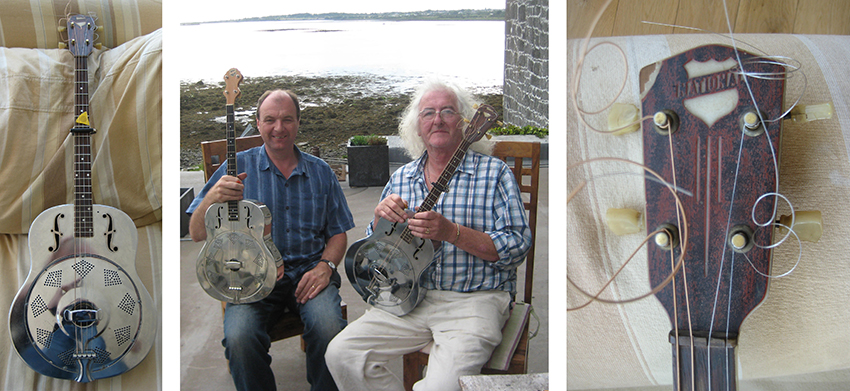
Alec gathered instruments right through his life, and bits of old waldzithers, mandolas, guitars and lutes have gathered dust and gently faded away in corners of Oranmore Castle over the decades.
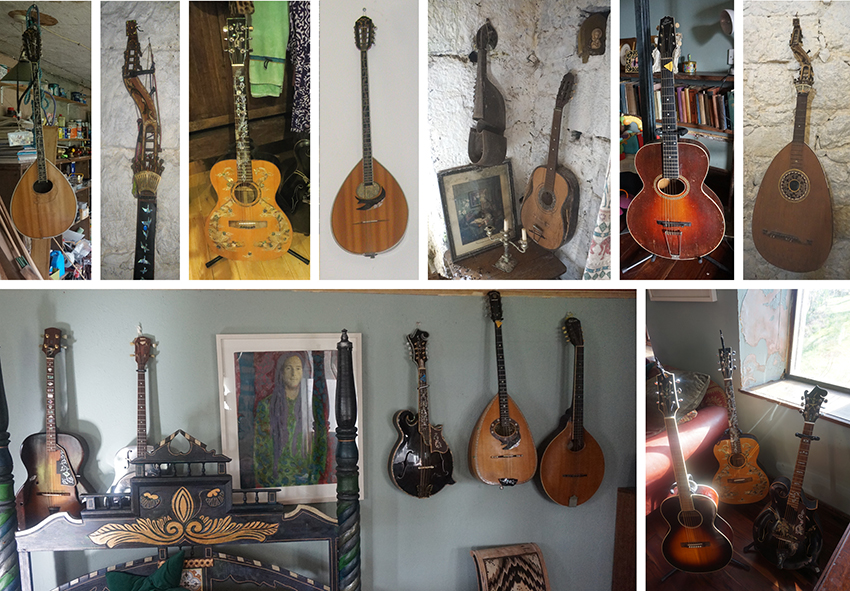
I should note here that Alec basically had one working bouzouki at any one time, with no specific backup instrument. It is to the credit of the Greek luthiers that they made such seemingly delicate looking instruments, usually without truss rods, last the pace of arduous touring. Each became a real workhorse for Alec and they coped with international air travel, temperature and humidity changes and much continuous professional playing, indeed by a big, powerful man with large hands.
When Alec visited me in Edinburgh, as he did often over the years of a long friendship, he always used the Dekavallas trichordo that I had brought back from Thessaloniki in 1998, and used it on two of my recordings and a BBC Radio Scotland broadcast that we did together. He also recorded with an old wooden tenor guitar I have, and a 1950s Fender lapsteel electric slide guitar.
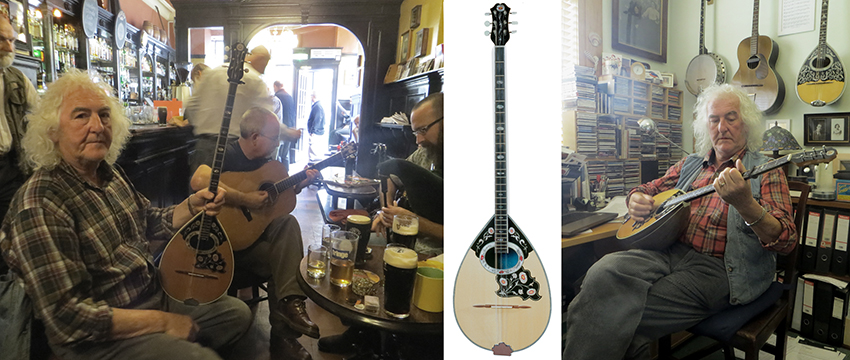
Alec Finn with singer George Duff & piper Mike Katz
in Sandy Bell's Bar, Edinburgh, 2016
It’s worth mentioning and showing a few of Alec’s other main instrument, the guitar. He rarely chose the guitar when accompanying sets of tunes, except for the odd set of slower melodies, primarily favouring the bouzouki. The ukulele had been his very first instrument, and that quickly led him into the guitar at a young age. He was an accomplished fingerstyle player, and wove delicate and hugely complimentary patterns under the songs of the numerous singers that passed through De Danann’s ranks over the decades.
He seems to have had quite a number of different guitars over time, and it’s hard to assess which is which, as he generally used whatever was to hand. I recall that he used Brendan O’Reagan’s guitar on the 1983 USA tour to accompany Mary Black, to save having to take two guitars on the road. There was an old wooden Martin style guitar during the 1980’s “Molly” era, and a Rick Turner made acousticaster type of guitar. He had a modern reproduction shiny metal tricone resonator guitar, which he loved playing alongside his lifelong pal and country blues singer Rick Ward. Alec had one of Johnny McDonagh’s highly ornate guitars from the Far East, and he played that and the resonator on the TG4 documentary that premiered in November 2018. https://www.tg4.ie/en/player/categories/irish-music-series/play/?pid=5858348933001&title=Alec%20Finn&series=S%C3%A9%20Mo%20Laoch%20&genre=Ceol&pcode=063134
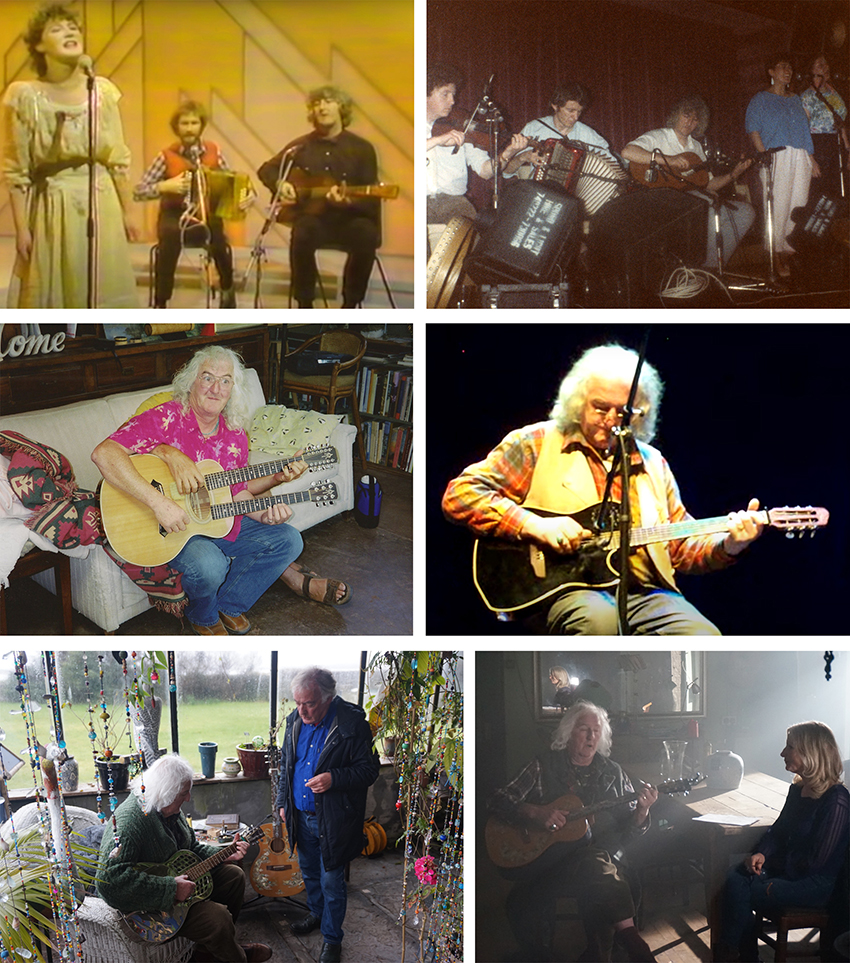
Finally, in writing this account, bouzouki player John Ryan in Dublin pointed me towards a great image of Alec and Charlie Piggott holding two flat backed instruments, made in Illinois by American luthier Rich Westerman. This was probably taken in the late 1970s/early 1980s, as Piggott left the band around 1981. Rich tells me that he made two 3 course instruments for Alec at that time, both at 25” scale length; one was spruce & bigleaf maple, the other cedar over sassafras. I have no knowledge of what became of either of these instruments.
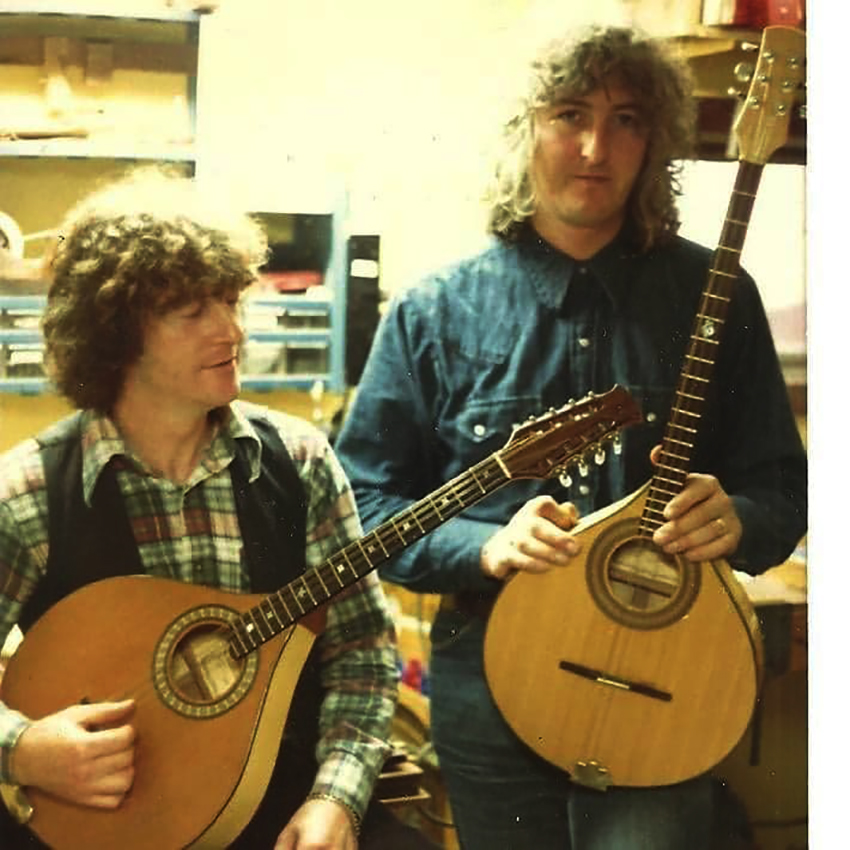
At some point in Alec’s travels round America, he must have come across the unusual triangular Herdim Appalachian dulcimer plectrum, with three different weights at each corner. He used these for years afterwards, and others have followed suit, as they produce a lovely bright sparkle from the strings. The dirty yellow one was one of Alec’s! I see these being used al lot by modern followers of the unique style.
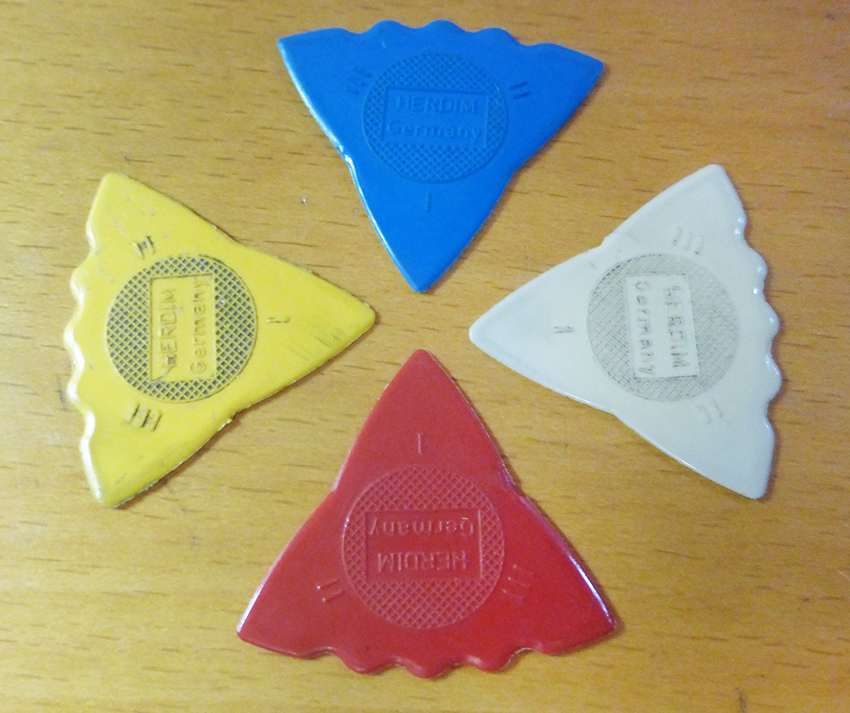
So, that is a rundown of the principal instruments that Alec Finn played over a long and illustrious career with De Danann, and adding his magical sound to dozens of other recordings by a wide range of top class traditional musicians. It is by no means a comprehensive list of his instruments, but hopefully sheds some light on the ones he recorded with in such a groundbreaking way, and documents how he certainly was most influential in introducing these unusual instruments and new sounds into Irish traditional music.
I end with a photograph of mine taken at the last De Danann gig I saw in Cork in 2017, a hugely memorable and poignant occasion for me.

Many of the images here are screenshots copied off the internet, and I am grateful for their presence on line, and hope the use here is acceptable.
The rest are from my own archive of photographs.
Kevin HJ Macleod, Edinburgh, Scotland 27th October 2020 www.kevinmacleod.co.uk
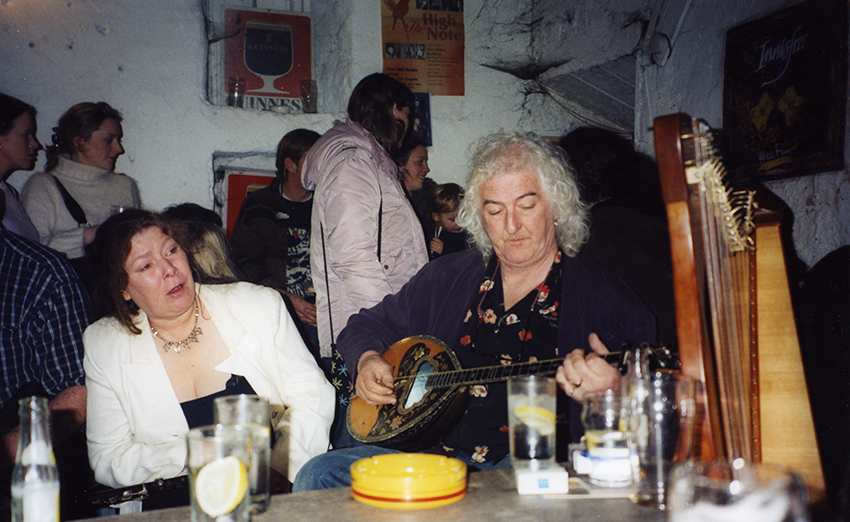
Dolores Keane & Alec Finn, cd launch of Alec's "Innisfree" recording, Tully's Bar, Kinvara, Ireland, 2003
